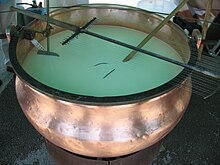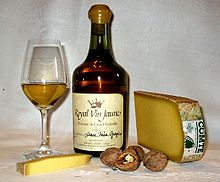Comté (cheese)
Comté [ kote ] is a hard - raw milk cheese from the French region of Franche-Comte .
Protection seal: Appellation d'Origine Protegée
For a cheese to be labeled as Comté by means of the French protection seal Appellation d'Origine Protegée , a cheese must meet the following conditions in particular:
- Parts of the Jura , Doubs , Ain and a small part of Saône-et-Loire are permitted as origin .
- The milk may only come from cattle of the Montbéliard breed and Simmental française .
- The feed may only consist of plants from the Jura meadows, silage is prohibited.
- The maturity period must be at least four months.
Manufacturing
Comté is usually made in small cheese dairies (French: fruitière ) run by cooperatives.
Around 450 liters of milk are required to make a 40 kilogram Comté cheese wheel. The milk is heated to 33 ° C in copper tubs and rennet is added. Quark mass and whey separate . After the milk has curdled , the thick (jelly) is broken into pieces the size of rice grains and heated to 53 degrees while stirring carefully. About 30 minutes later, the mass is poured into a mold, pressed for 24 hours and turned at regular intervals. As soon as the mass has drained off, the cheese is placed in the warming or pre-maturing cellar for temporary storage.
The cheese is then stored in ripening cellars for at least four months, regularly turned and rubbed with salt. Maturing times of up to 24 months are typical. Cheeses that have matured for three or four years are also rarely offered. The cheese wheel is cylindrical with a diameter of 65–70 cm, a height of 8–13 cm, a slightly cambered edge and a weight between 30 and 48 kg with a fat content of 45–48%.
Every loaf that leaves the maturing cellar is judged by a jury of experts. A maximum of 20 points can be achieved. Only cheeses with over 15 points receive the green "COMTÉ Extra" band. With 13 to 15 points they get a brown banderole. If fewer points are scored, the cheese may not be sold as Comté; it is marked with a grid in the rind.
Historical
Comté has been produced in the region of the same name for over 1000 years. The cheese was a safe food for the rural population during the long and very snowy winters.
use
Comté has a much milder taste than, for example, Gruyère cheese from Switzerland. Its aromas are varied and vary depending on the season. It is suitable for a fondue or as an aperitif, it is also recommended with seafood and fish.
Dry white wines, preferably from the Jura, and champagne are often served with this. Light red wines also match its aroma or even a vin jaune with nuts.
Manufacturing plants
The production area extends over around 12,000 km², on which 3,351 companies are involved in the Comté production. Of these, 3,163 are milk producers, 175 cheese factories (138 cooperatives and 37 industrial companies) and 188 processing companies that produce around 45,000 tons of Comté annually.
Single receipts
- ↑ a b Comté - Fiche produit. L'Institut National de l'Origine et de la Qualité (INAO), accessed on December 29, 2019 (French).
- ^ Anne Iburg: DuMonts little cheese lexicon. Production, origin, varieties, taste. DuMont Monte, Cologne 2003, ISBN 3-8320-8824-5 .
Web links
- Website Comté (German)
- Web presence of the Comté producers (English, French)




